“SPI LED strips offer individual LED control for advanced, dynamic lighting effects. PWM LED strips provide uniform brightness control ideal for simpler lighting setups. Clearly understanding these differences helps you choose the perfect LED strip for your project.”
Introduction to SPI and PWM LED Strips
Drawing from my experience installing various LED lighting solutions, I clearly understand the distinct differences between SPI and PWM LED strips. Let me briefly introduce each type to help you choose the ideal solution for your project.
What Are SPI LED Strips?
SPI (Serial Peripheral Interface) LED strips provide individual or segment-level control through data signals. This allows dynamic lighting effects, precise brightness adjustments, and detailed color customization. Clearly ideal for advanced decorative applications, event lighting, and detailed visual displays.
What Are PWM LED Strips?
PWM (Pulse Width Modulation) LED strips control brightness by varying power input uniformly across entire segments or strips. They offer simpler and consistent lighting effects, clearly ideal for general accent lighting, straightforward installations, and cost-effective solutions.
Clients frequently ask me, “What’s the main difference between SPI and PWM LED strips?” Clearly, SPI offers detailed individual control for dynamic effects, whereas PWM provides simpler, segment-based control ideal for uniform illumination.
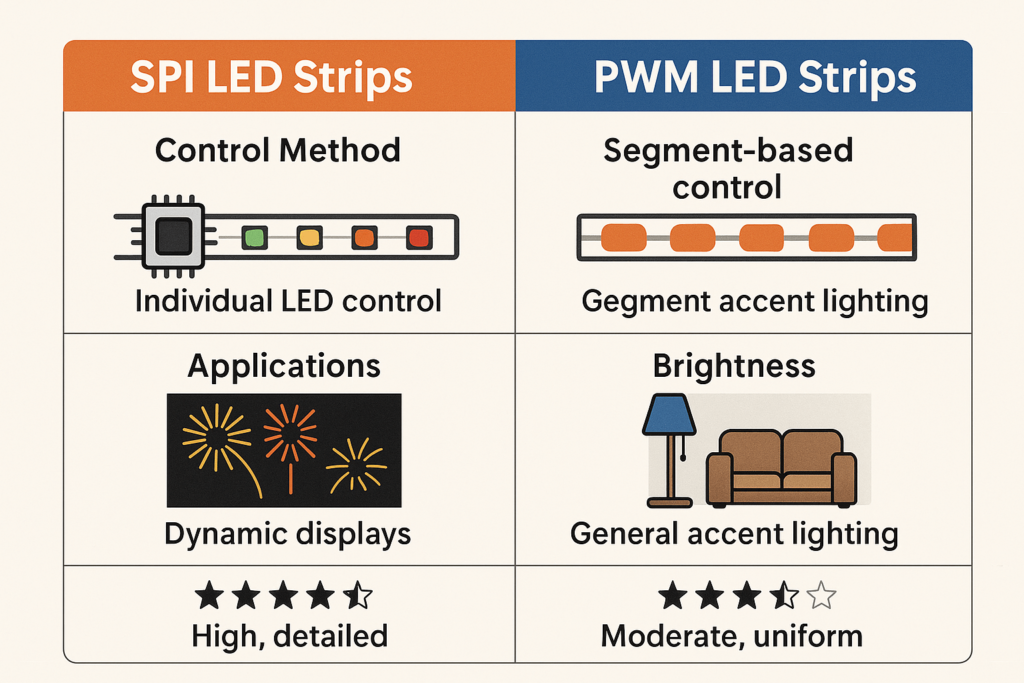
Technical Differences Clearly Explained
Drawing from my practical experience installing SPI and PWM LED strips, I clearly understand the key technical differences. Here’s a straightforward comparison to guide your lighting choice:
Lighting Control & Customization
- SPI LED Strips:
Allow individual LED or segment-specific control, clearly enabling advanced dynamic effects, detailed animations, and customized brightness levels for each LED or group.
- PWM LED Strips:
Provide uniform brightness control for entire strips or large segments. Clearly simpler and suitable for general illumination without individual LED customization.
Brightness & Lighting Quality
- SPI LED Strips:
Offer precise, detailed brightness and lighting customization, clearly ideal for decorative and dynamic lighting installations requiring detailed visual effects.
- PWM LED Strips:
Provide uniform, consistent brightness, clearly ideal for general ambient and decorative lighting applications without detailed brightness adjustments.
Installation Complexity & Compatibility
- SPI LED Strips:
Installation involves detailed planning for data wiring, specialized SPI controllers, and power management. Clearly suited for professional or advanced lighting projects.
- PWM LED Strips:
Offer simpler installation processes, clearly easier handling and wiring, suitable for DIY and straightforward lighting projects.
Clients frequently ask me, “Is SPI always better than PWM?” Clearly, SPI is preferable for complex, detailed lighting setups needing individual control, while PWM is better for simpler, straightforward applications.
Comparison Table:
| Feature |
SPI LED Strips |
PWM LED Strips |
| Lighting Control |
Contrôle individuel des LED |
Segment-based control |
| Brightness Customization |
High, detailed |
Moderate, uniform |
| Dynamic Effects |
Extensive and complex |
Basic and limited |
| Complexité de l'installation |
Moderate to high |
Moderate |
| Ideal Applications |
Events, dynamic displays |
General accent lighting |
| Coût |
Moderate to higher |
Cost-effective |
Advantages and Disadvantages of SPI LED Strips
Having personally installed SPI LED strips across numerous projects, I clearly understand their strengths and potential limitations. Here’s a straightforward summary to guide your lighting decisions:
Advantages of SPI LED Strips
- Individual LED Control:
Clearly enables detailed, dynamic lighting effects and customizable animations, making them ideal for advanced decorative or event-based installations.
- Dynamic Lighting Effects:
Offer extensive visual customization and detailed control over brightness, color, and animations, clearly enhancing visual appeal in detailed applications.
- Versatile Applications:
Clearly suited for events, entertainment spaces, commercial displays, and intricate decorative lighting projects.
Disadvantages of SPI LED Strips
- Complex Installation:
Clearly require detailed planning, specialized controllers, and careful wiring, often necessitating professional installation or advanced DIY skills.
- Higher Initial Cost:
Generally more expensive than PWM LED strips due to advanced control capabilities and detailed components.
Clients frequently ask me, “Are SPI LED strips worth the additional cost and complexity?” Clearly, if your lighting project requires intricate, detailed, and dynamic effects, the additional investment and complexity of SPI LED strips is justified.
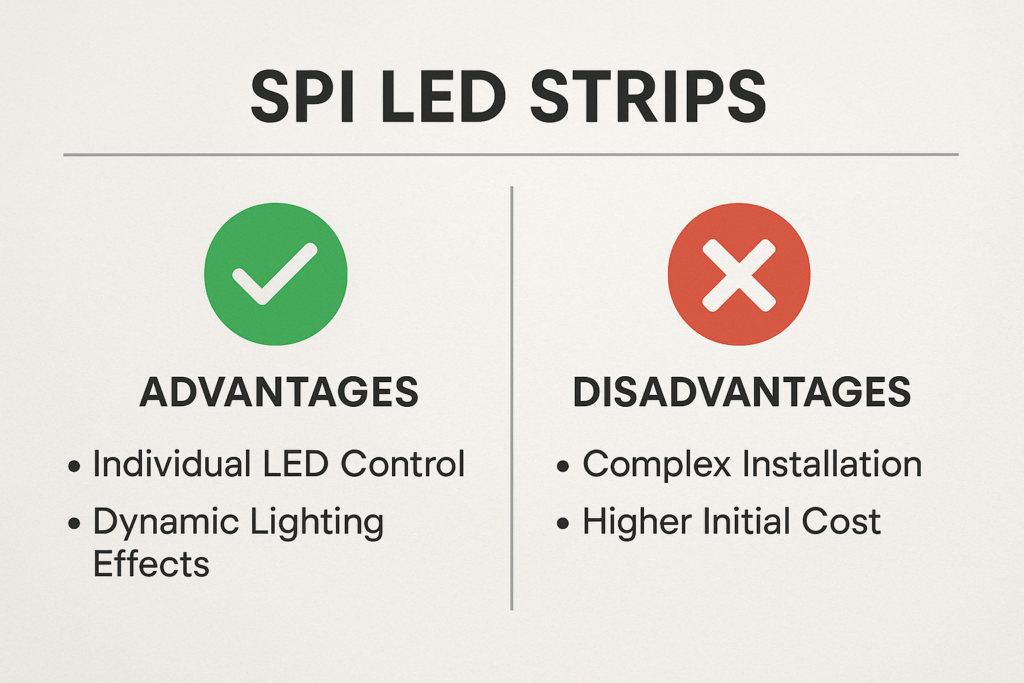
Advantages and Disadvantages of PWM LED Strips
Drawing from my practical experience installing PWM LED strips, I clearly understand their practical strengths and limitations. Here’s a straightforward summary to help you decide if PWM LED strips fit your needs.
Advantages of PWM LED Strips
- Easy Installation:
PWM strips have a simpler installation process, clearly suitable for DIY projects and general applications.
- Cost-Effective:
Typically more affordable upfront compared to SPI strips, clearly beneficial for budget-conscious lighting projects.
- Reliable, Uniform Illumination:
Provide consistent brightness across entire strips or segments, clearly ideal for general residential or commercial accent lighting.
Disadvantages of PWM LED Strips
- Limited Customization:
Clearly lack detailed individual LED control, limiting their suitability for complex, dynamic effects.
- Basic Lighting Effects:
Offer limited options for animations or dynamic color changes, clearly suited primarily to straightforward illumination setups.
Clients frequently ask me, “Are PWM LED strips suitable for detailed decorative installations?” Clearly, PWM LED strips are excellent for general, simple decorative lighting but are less suitable for detailed or dynamic lighting applications requiring individual LED control.
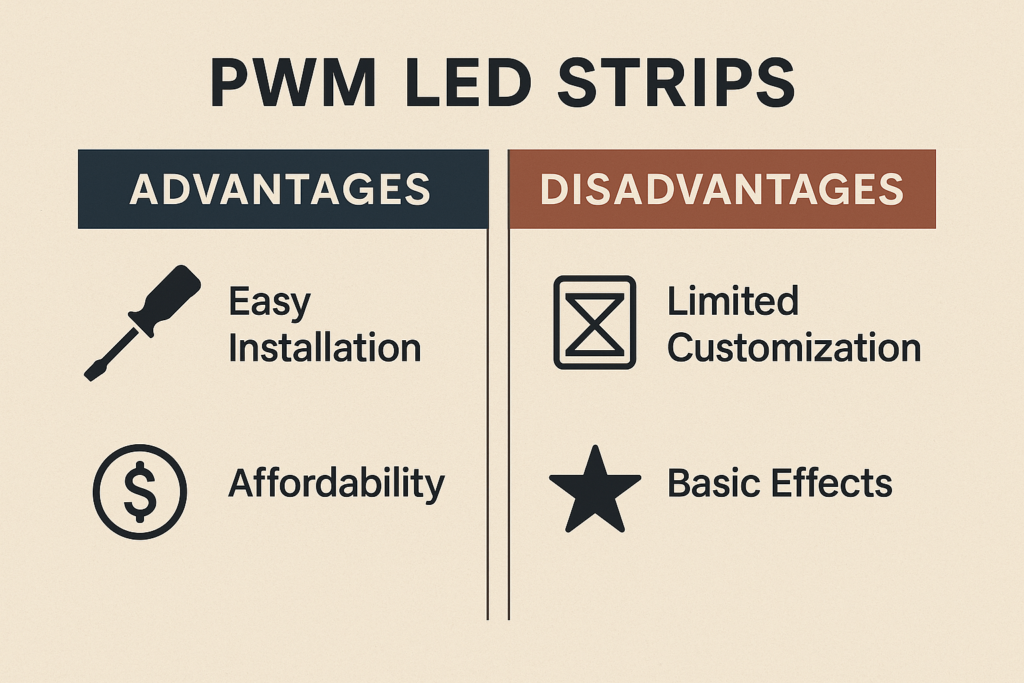
Best Applications & Practical Scenarios
Having installed both SPI and PWM LED strips across various projects, I clearly understand their ideal uses. Here’s practical guidance to help you choose the best LED lighting for your project:
Ideal Uses for SPI LED Strips
SPI LED strips clearly excel in dynamic, detailed lighting scenarios, including:
- Event and Entertainment Lighting:
Ideal for events, stages, and entertainment spaces that require dynamic visual effects and intricate lighting patterns.
- Commercial Displays:
Clearly suited for retail stores, product showcases, or trade show booths requiring eye-catching and customizable lighting animations.
- Advanced Decorative Installations:
Excellent for detailed architectural lighting, decorative displays, or complex visual installations clearly benefiting from detailed control.
Ideal Uses for PWM LED Strips
PWM LED strips clearly perform best in straightforward, uniform lighting scenarios such as:
- General Residential Lighting:
Ideal for under-cabinet kitchen lighting, living room accents, or simple decorative illumination.
- Commercial Ambient Lighting:
Suitable for offices, retail spaces, and commercial environments clearly needing consistent, reliable lighting.
- Basic Decorative Applications:
Clearly effective for creating ambiance in restaurants, cafes, or straightforward decorative lighting projects.
Clients frequently ask me, “Should I choose SPI or PWM LED strips for my lighting project?” Clearly, SPI strips offer detailed, dynamic effects suitable for complex installations, while PWM strips provide uniform, easy-to-use lighting for simpler scenarios.

How to Choose Between SPI and PWM LED Strips
Drawing from my hands-on experience installing both SPI and PWM LED strips, here’s clear, practical guidance to help you select the ideal LED control method for your lighting needs.
Key Decision Factors
- Lighting Complexity & Customization:
SPI LED strips are clearly best suited for applications demanding detailed, dynamic effects with individual LED control. PWM LED strips clearly fit simpler, uniform illumination setups without detailed customizations.
- Installation Complexity:
PWM LED strips offer a straightforward installation clearly suitable for DIY and general installations. SPI strips clearly require detailed wiring, compatible controllers, and careful planning.
- Budget Considerations:
Clearly define your budget—PWM strips typically offer greater affordability and are ideal for simpler projects, while SPI strips come at a higher initial cost but offer advanced lighting customization.
- Application Environment:
Clearly evaluate where the lights will be installed. SPI strips excel in event settings, commercial displays, or decorative projects needing advanced effects, while PWM strips clearly suit residential or simpler commercial spaces.
Common Mistakes & Practical Recommendations
- Misjudging Lighting Complexity:
Clearly avoid choosing SPI strips unnecessarily for straightforward lighting tasks, and PWM strips when detailed customization is needed.
- Overlooking Installation Needs:
Clearly prepare for the complexity involved with SPI strip installations, ensuring suitable power supplies and controllers.
- Choosing Solely Based on Price:
Clearly consider long-term effectiveness, customization capabilities, and installation complexity instead of just upfront costs.
Clients frequently ask me, “Is SPI always better than PWM for LED strips?” Clearly, it depends on your specific lighting requirements. SPI LED strips are ideal for complex, detailed lighting projects, while PWM LED strips clearly excel in simple, straightforward applications.
External Link:
SPI vs PWM LED Strip Control – LEDSupply
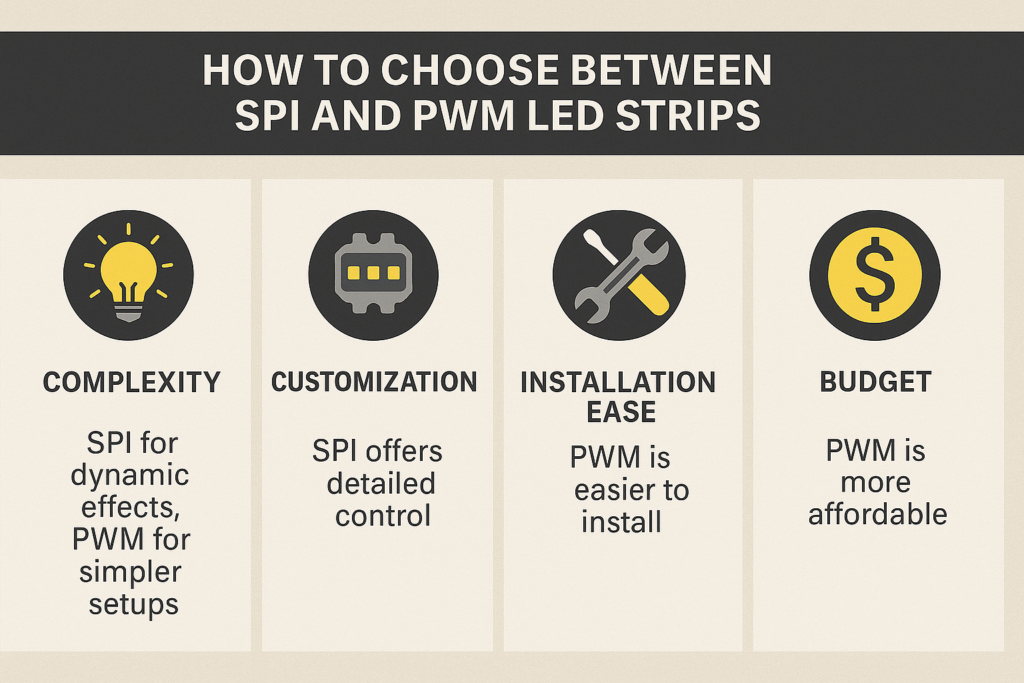
Installation, Maintenance & Expert Recommendations
Drawing from my hands-on experience installing both SPI and PWM LED strips, I clearly understand what’s necessary for smooth installation, maintenance, and troubleshooting. Here’s clear, practical advice to help you successfully manage your lighting setup.
Installation Recommendations
- SPI LED Strips:
Clearly plan your installation carefully, ensuring proper wiring, compatible controllers, and power supplies. Securely mount strips using channels or clips for stability.
- PWM LED Strips:
Installation is straightforward—clearly prepare your surface, secure strips with adhesive backing or mounting clips, and connect to the appropriate PWM-compatible controller and power source.
Essential Maintenance Practices
- Routine Inspections:
Regularly inspect LED strips for brightness consistency, secure connections, and any signs of wear or damage.
- Proper Cleaning:
Occasionally clean strips gently with a soft cloth, clearly ensuring they remain dust-free and bright.
- Heat Management (for Both Types):
Clearly ensure adequate heat dissipation by using mounting channels or aluminum heat sinks, especially important in high-brightness setups.
Dépannage des problèmes courants
- Inconsistent Brightness or Flickering:
Clearly verify connections, appropriate controller compatibility, power supply, and proper wiring.
- Strips Not Lighting:
Ensure clearly correct polarity, verify connections, and ensure sufficient voltage from power supplies.
- Installation Adhesion Problems:
Clearly prepare surfaces properly and consider additional mounting methods such as clips or mounting channels for better durability.
Clients often ask me, “What are common installation issues with SPI and PWM LED strips?” Clearly, common challenges include improper wiring, inadequate power planning, incorrect controller compatibility, and insufficient surface preparation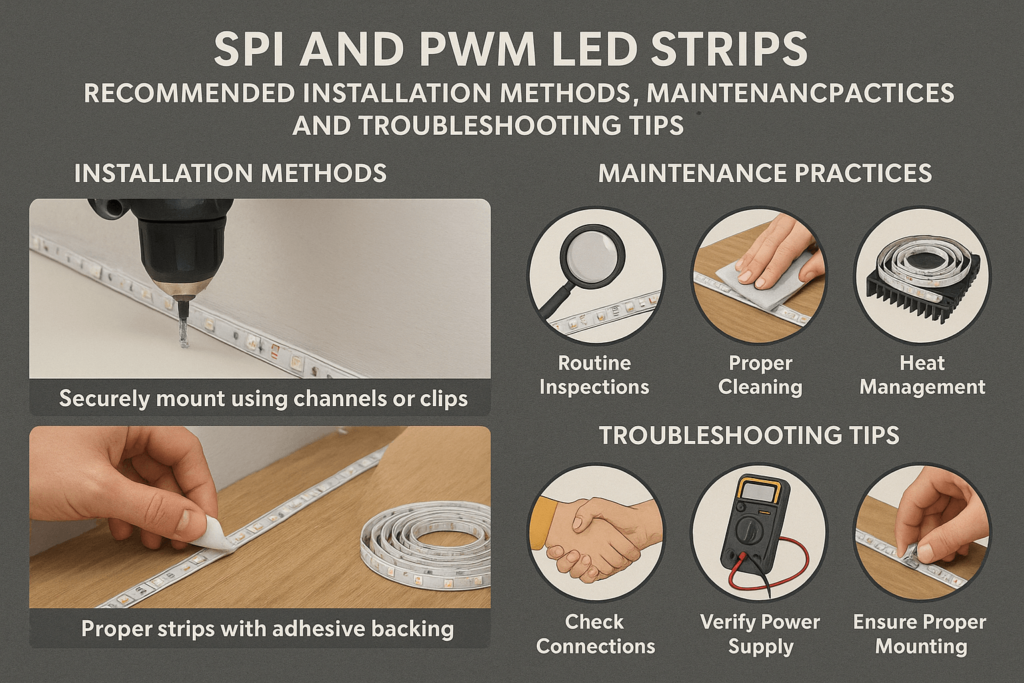
FAQs About SPI and PWM LED Strips
Drawing from my extensive installation experience, here are clear, practical answers to common questions people frequently ask about SPI and PWM LED strips.
What’s the difference between SPI and PWM LED strips?
SPI LED strips provide individual or segment-level control, clearly enabling detailed, dynamic lighting effects. PWM LED strips control brightness uniformly across the strip or segments, suitable for simpler lighting setups.
Which LED strip control is better, SPI or PWM?
Clearly, SPI is better suited for applications needing intricate, customizable lighting effects, while PWM is ideal for general, simpler decorative lighting with uniform brightness.
Can SPI LED strips provide better dynamic effects than PWM?
Yes, SPI LED strips clearly offer advanced individual control and dynamic effects, significantly surpassing PWM strips in terms of customizable animations and detailed lighting scenarios.
Conclusion & Next Steps
Clearly understanding the differences between SPI and PWM LED strips enables you to confidently select the perfect lighting solution for your project. SPI LED strips offer advanced, individual LED control and detailed, dynamic effects, ideal for event lighting, commercial displays, and creative installations. PWM LED strips provide simpler, uniform lighting solutions that are cost-effective and easy to install, suited for general residential or straightforward commercial applications.
Evaluate your project’s specific requirements carefully—such as desired lighting effects, installation complexity, and budget considerations—to clearly choose the ideal solution.
Ready to find the perfect LED strip lighting for your project?
Explore Elstar’s LED Lighting Solutions →







